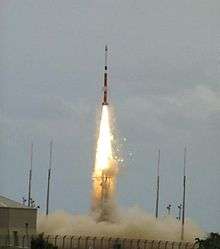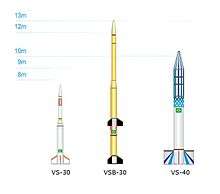VSB-30
VSB-30 - "Veículo de Sondagem Booster – 30" (Booster Sounding Vehicle) or "Foguete Suborbital VSB-30" is the designation of a Brazilian sounding rocket, which replaced the Skylark rocket at Esrange.
 VSB-30 V07 rocket | |
| Function | Sounding rocket |
|---|---|
| Manufacturer | Instituto de Aeronáutica e Espaço |
| Country of origin | Brazil |
| Size | |
| Height | 12,6 m |
| Diameter | 0.57 m |
| Mass | 2,570 kg |
| Stages | 2 |
| Capacity | |
| Payload to Suborbital (270 km) | 400 kg |
| Launch history | |
| Status | Active |
| Launch sites | Alcântara Esrange |
| First flight | 2004 October 23 |
| First stage - S-31 | |
| Engines | 1 Solid |
| Thrust | 240.00 kN |
| Burn time | 11 seconds |
| Propellant | Solid |
| Second stage S-30 | |
| Engines | 1 Solid |
| Thrust | 102.00 kN |
| Burn time | 20 seconds |
| Propellant | Solid |

VSB-30 rocket assembly
The VSB-30 is based on the VS-30 rocket (S-30 engine) with the addition of a booster stage (S-31 engine). Development started in 2000 in cooperation with DLR. The rocket can therefore carry a payload of 400 kg to an altitude of 270 km. It has a liftoff thrust of 240 kN and a total mass of 2570 kg. It has a diameter of 0.57 m and a length of 12.6 m.
VSB-30 was first launched on October 23, 2004 at Alcântara Launch Center. The first launch at Esrange took place on December 1, 2005.
Flights[1][2]
- VSB-30 XV-01 - "Cajuana test" - 2004 October 23 - Apogee: 240 km
- VSB-30 V02 -"TEXUS EML-1/TEXUS 42 Microgravity mission" - 2005 December 1 - Apogee: 263 km
- VSB-30 V03 -"TEXUS 43 Microgravity mission" - 2006 May 10 - Apogee: 237 km
- VSB-30 V04 -"Cuma II Microgravity mission" - 2007 July 19 - Apogee: 242 km
- VSB-30 V05 -"DLR TEXUS 44 (EML-2)" - 2008 February 7 - Apogee: 264 km
- VSB-30 V06 -"DLR TEXUS 45" - 2008 February 21 - Apogee: 270 km
- VSB-30 V08 -"MASER 11" - 2008 May 15 - Apogee: 252 km
- VSB-30 V09 -"TEXUS 46" - 2009 November 22
- VSB-30 V10 -"TEXUS 47" - 2009 November 29
- VSB-30 V07 -"MICROG 1A" - 2010 December 12 - Apogee: 242 km
- VSB-30 V15 -"TEXUS 49" - 2011 March 29 - Apogee: 268 km
- VSB-30 V14 -"TEXUS 48" - 2011 March 29 - Apogee: 268 km
- VSB-30 V16 -"MASER 12" - 2012 February 13 - Apogee: 259 km[3]
- VSB-30 V17 -"TEXUS 50" - 2013 April 12
- VSB-30 V20 -"CRYOFENIX" - 2015 February 22
- VSB-30 V13 -"HIFiRE 7" - 2015 March 30
- VSB-30 V18 -"TEXUS 51" - 2015 April 23
- VSB-30 V21 -"TEXUS 52" - 2015 April 27
- VSB-30 V24 -Mapheus 5 - 2015 July 30
- VSB-30 V22 -"MASER 13" - 2015 December 1
- VSB-30 V23 -"TEXUS 53" - 2016 January 23
- VSB-30 V11 - "MICROG 2" - 07.12.2016
- VSB-30 V19 - "MAIUS 1" - 23.01.2017
- VSB-30 - MAPHEUS 6 - 13.05.2017
- VSB-30 V12 - "HIFiRE 4a / HIFiRE 4b" - 30.06.2017
- VSB-30 - "MASER-14" - 24.06.2019 - Apogee: 260 km
- VSB-30 - "TEXUS-56" -15.11.2019 09:35 (UTC) - Apogee: 256 kilometres
Characteristics

VSB-30 configuration
- Length (mm) 12600
- Stages 2
- Payload Mass (kg) 400
- Diameter (mm) 570
- Total takeoff mass (kg) 2570
- Apogee (km) 270
Stages
S-30 solid rocket stage:
- Gross Mass 1,200 kg (2,646 lb)
- Unfuelled mass: 341 kg (752 lb)
- Height: 3.30 m (10.80 ft)
- Diameter: 0.56 m (1.83 ft)
- Thrust: 102.00 kN (22,930 lbf)
- Burn time: 20 s
S-31 solid rocket stage.
- Gross Mass 900 kg (1,984 lb)
- Unfuelled mass: 284 kg (626 lb)
- Height: 3.20 m (10.40 ft)
- Diameter: 0.56 m (1.83 ft)
- Thrust: 240.00 kN (53,950 lbf)
- Burn time: 11 s
References
- "Archived copy". Archived from the original on 2015-08-24. Retrieved 2015-08-05.CS1 maint: archived copy as title (link)
- "S-30 family". space.skyrocket.de.
- "IAE Lança Com Sucesso Mais um Foguete VSB-30".
External links
- History of brazilian space launchers: VSB-30 (in Portuguese)
- Space Agency of Brazil: VSB-30 (in Portuguese)
| Wikimedia Commons has media related to VSB-30. |
This article is issued from Wikipedia. The text is licensed under Creative Commons - Attribution - Sharealike. Additional terms may apply for the media files.
